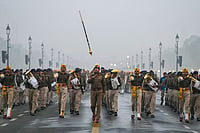This was hardly an understatement: by the seventeenth century, Agra had grown larger than even Constantinople, and with its two million inhabitants, dwarfed both London and Paris. A succession of riverside palaces and "sweet-smelling gardens with sweet blossoms" spanned both banks of the river Jamuna. As the Mughal chronicler Abdul Aziz put it, the city was "the wonder of the age—as much a centre of the arteries of trade both by land and water as a meeting place of saints, sages and scholars from all Asia...a veritable lodestar for artistic workmanship, literary talent and spiritual worth."
It was the Emperor Shah Jahan (1592-1666) who was responsible for the jewel of the Agra waterfront, and the Mughals’ most immortal creation, the Taj Mahal. The Taj, which was designed by Shah Jahan’s master architect Ustad Ahmad Lahauri, is arguably the most admired building of the past 400 years, a marble masterpiece rising still above the River Jamuna, as perfect, beautiful and shimmeringly symmetrical as it was when its great marble dome was first completed in 1643. The mausoleum was built in white marble in memory of Mumtaz Mahal, "the Chosen One of the Palace," Shah Jahan’s favourite wife, as a memorial to their marriage.
In the words of the court historian Muhammad Amin Qazwini, "The intimacy, deep affection, attention and favour which his Majesty had for the Cradle of Excellence [another title of Mumtaz] exceeded by a thousand times what he felt for any other. And always that Lady of the Age was the companion, close confidante, associate and intimate friend of that successful ruler, in hardship and comfort, when travelling or in residence.... The mutual affection and harmony between the two had reached a degree never seen between a husband and wife among the sultans and rulers, or among the ordinary people. And this was not merely out of sexual passion: the excellent qualities, pleasing habits, and physical and spiritual compatibility on both sides caused great love and affection, and extreme affinity and familiarity."
While Shah Jahan was capable of bouts of cold-blooded brutality—to seize the throne he had to rebel against his father and murder two of his brothers, their children and two cousins—he was nevertheless the most aesthetically sensitive of all the Mughals. As a boy of 15 he had impressed his father with the taste he demonstrated in redesigning the imperial apartments in Kabul. As a young emperor, he had rebuilt the Red Fort in a new imperial architectural style that he had himself helped to develop. The Taj was the culmination of his life of discriminating architectural patronage.
Most Mughal scholars agree that the mausoleum of Mumtaz Mahal was originally designed to be a model on earth of the heavenly mansion prepared for the emperor’s wife in paradise. It was also very deliberately designed to be a monument of political propaganda to the power, genius and good taste of Shah Jahan and his dynasty: "a dome of high foundation and a building of great magnificence was created," wrote Qazwini. "The eye of the Age has seen nothing like it under the nine vaults of the enamel blue sky, and ear of Time has heard of nothing like it in any past age...it will be a masterpiece for ages to come increasing the amazement of all humanity."
Yet for all its fame, remarkably little has been written on the Taj, and Giles Tillotson’s slim and balanced new book is, without question, the best short introduction to the building yet produced, and a worthy complement to Ebba Koch’s detailed scholarly monograph of two years ago, The Complete Taj Mahal, which reconstructed the entire architectural context of the Taj and revealed Agra to be a sort of Mughal Venice centred along the Jamuna waterfront. Tillotson’s account of the building of the Taj owes much to Koch; where he comes into his own is in his wonderful account of its many layers of meaning, and how different viewers have seen the Taj, each claiming it for their own in more or less subtle ways.
Thus, in the Company period, British artists like Daniells produced images of the Taj surrounded by English trees "of no species known to India...[that] create the impression we have stumbled on this scene in the corner of the park of an English county house." The Victorians went further. Convinced by the mid-19th century of racial inferiority of all Indians, they developed a ludicrous theory that the Taj—which owes nothing in any way to the influence of European architecture—was in fact the work of a European architect, either one Austin of Bordeaux or Geronimo Veroneo, both of whom were known to be in Agra at the time of its building.
Likewise, the Hindu supremacists of the 20th century have found it equally hard to believe that such a masterpiece was built by the same Muslims they despised. Thus the architectural historian Ram Nath in 1972 convinced himself that this masterpiece of high Mughal-Timurid style was in fact "not a monument of Islam" in the strict sense as it had, claimed Nath, been "produced in accordance with our ancient vastu canons".
More dotty still were the writings of P.N. Oak who, in what Tillotson calls a "startling piece of pseudo-scholarship," The Taj Mahal is a Hindu Palace (1968) ("The Greatest Historical Discovery of Modern Times") reassigned not just the Taj but all other Islamic buildings across the width of Asia to an ancient Hindu civilisation that once conquered the world, leaving traces in the place names as widely disparate as Argentina (derived, according to Oak, from the name of the Hindu hero, Arjun) and Salisbury ("formerly Shail-eesh-pury, signifying a hilly area and a Hindu temple."). In the same vein he believed that "Westminster Abbey is also a Shiva temple," and that "ancient Italy was a Hindu country and the Pope a Hindu priest." Alarmingly, Oak’s theories are still doing the rounds on the internet where they are widely believed in the more credulous corners of the Indian diaspora, and have formed the basis of a claim to the Taj by the Hindu revivalist Bajrang Dal, who have demanded that the Taj be ‘renamed’ the Tejo Mai Mahal and ‘reconverted’ into a Hindu temple.
Tillotson’s short, sensible and scholarly book is a wonderful antidote to this sort of nonsense, and briskly dismisses these and many other similar Taj myths and fables with the firm hand and steady tread of an authoritative umpire. This is a much-needed and eminently readable book which is likely to remain a standard work for many years to come.
(William Dalrymple’s most recent book, The Last Mughal [Penguin India], won the Duff Cooper Prize for History and the Crossword-Vodafone Indian Book of the Year Prize).


























